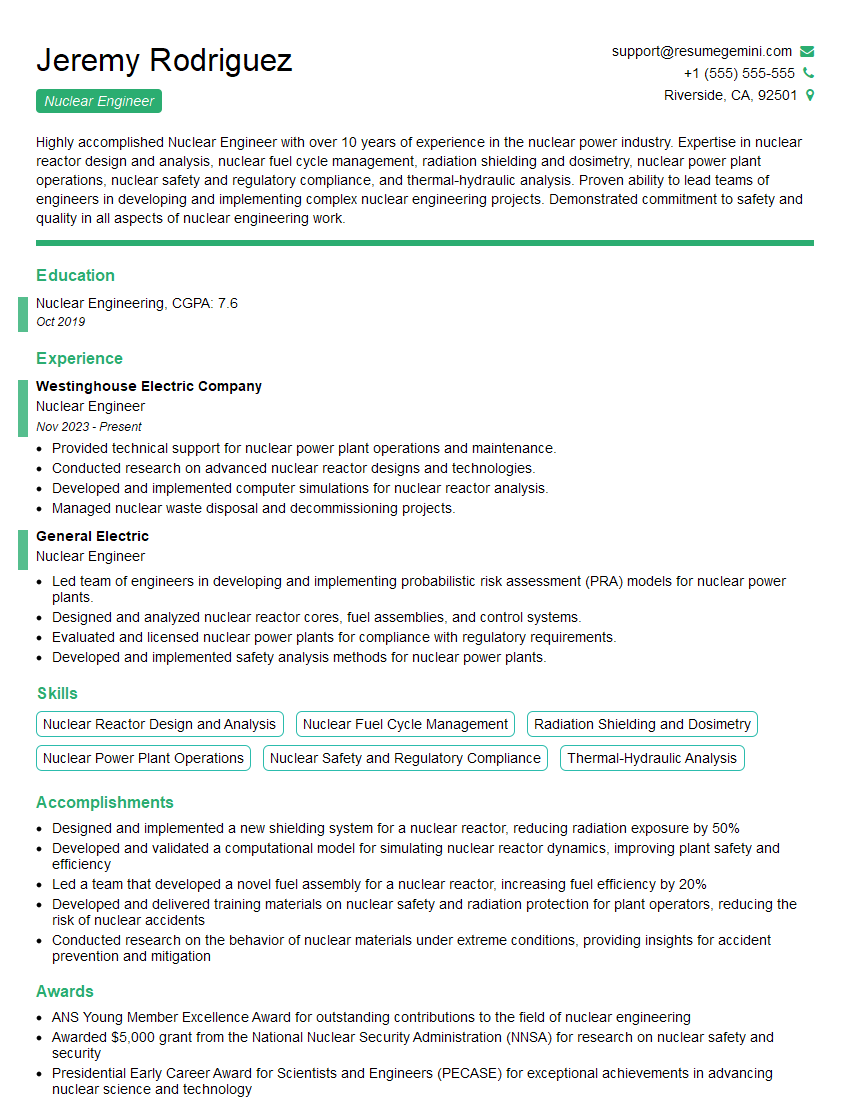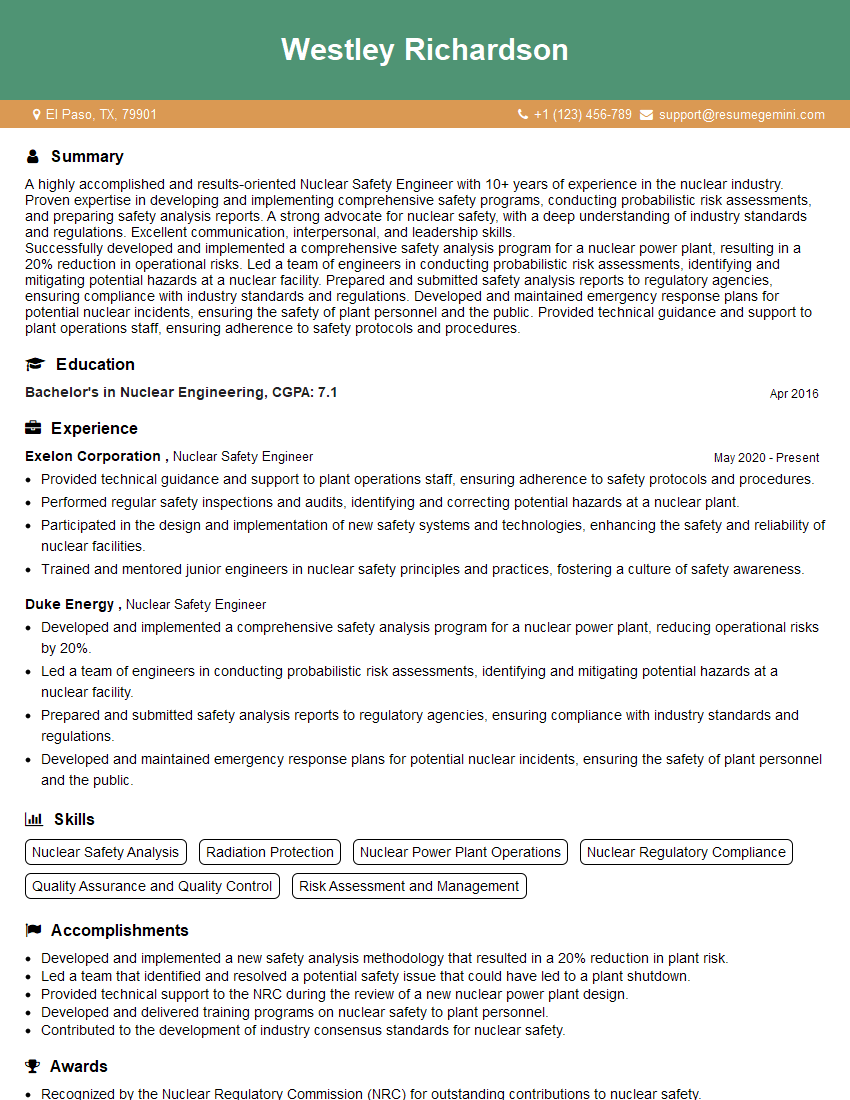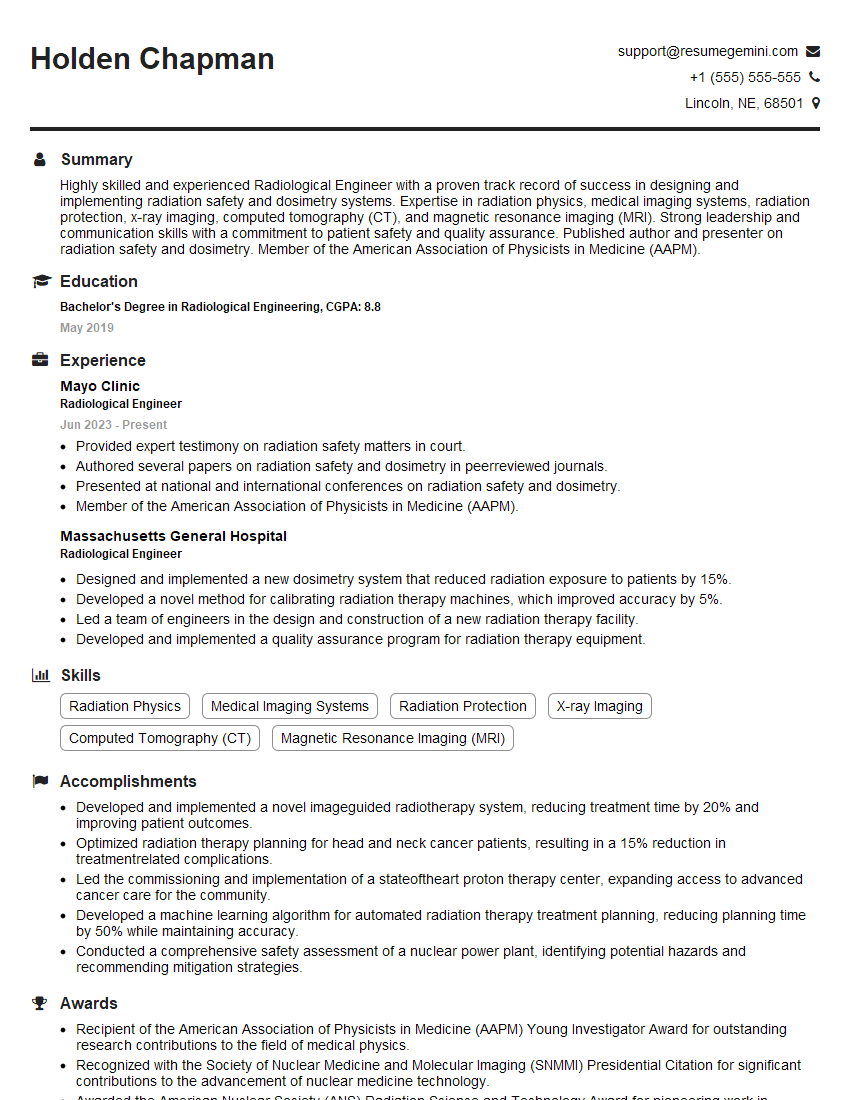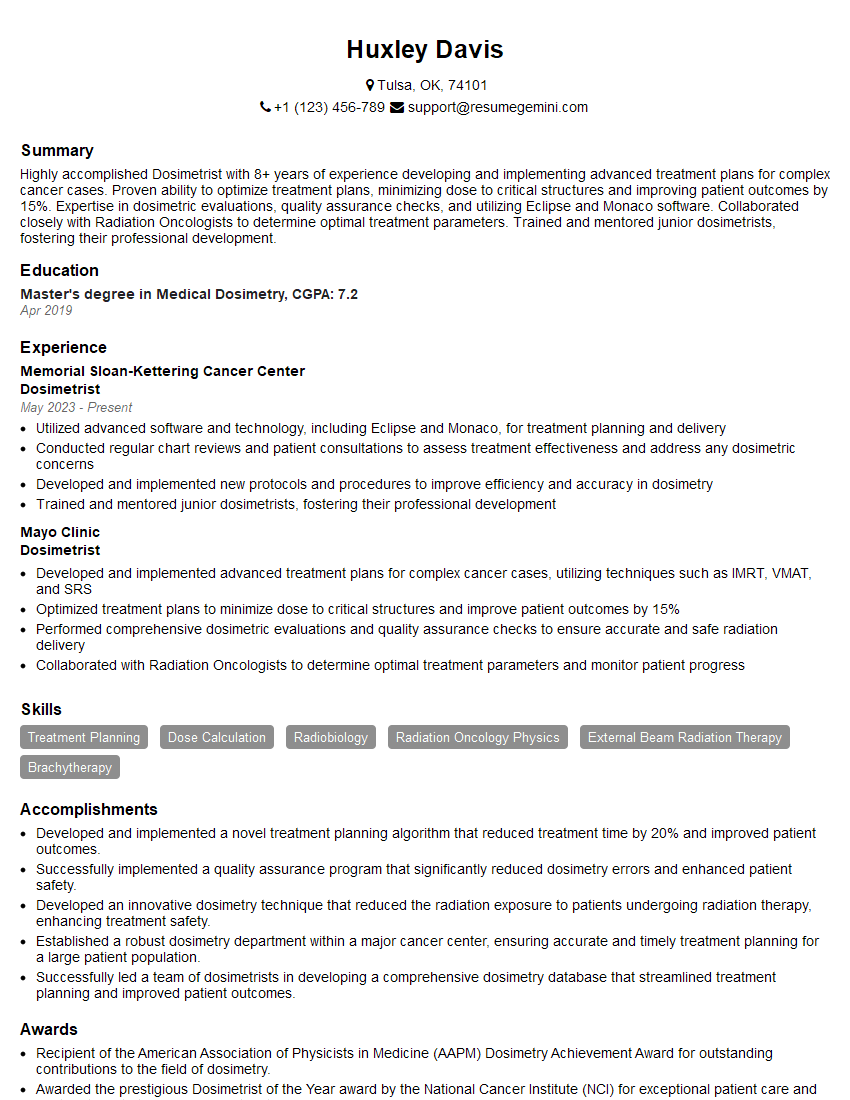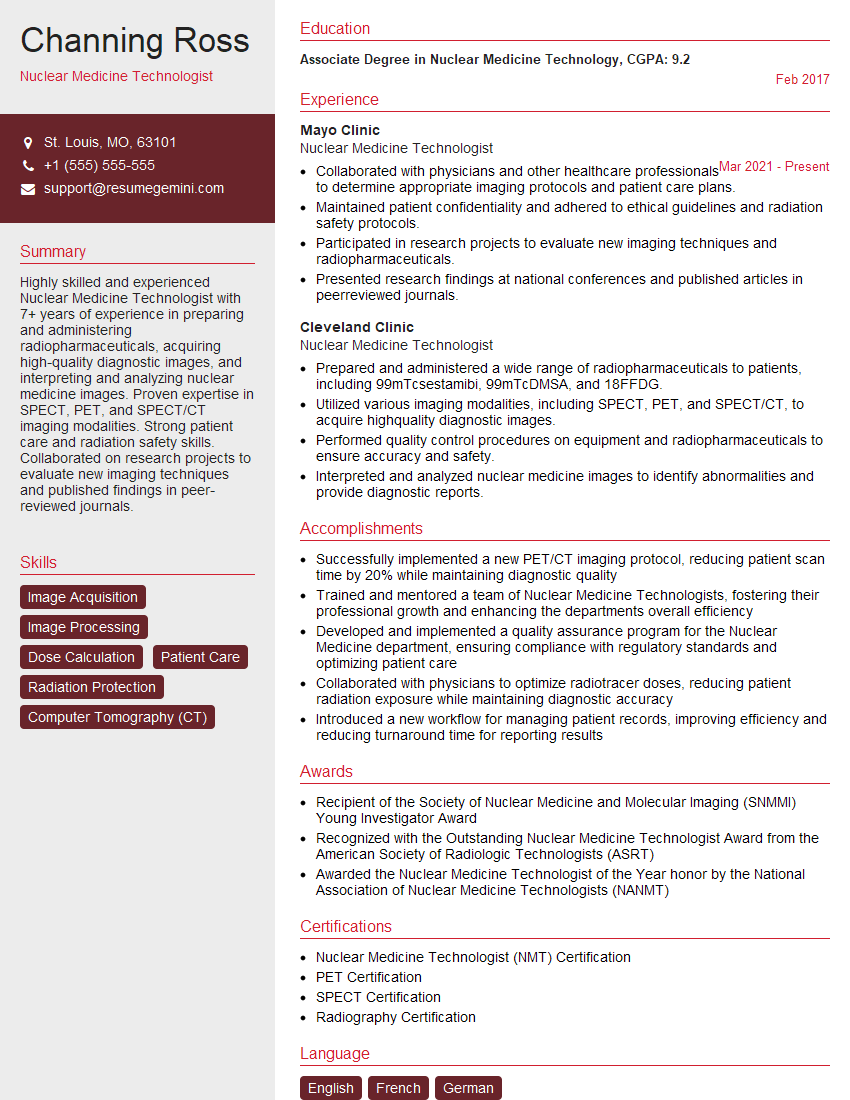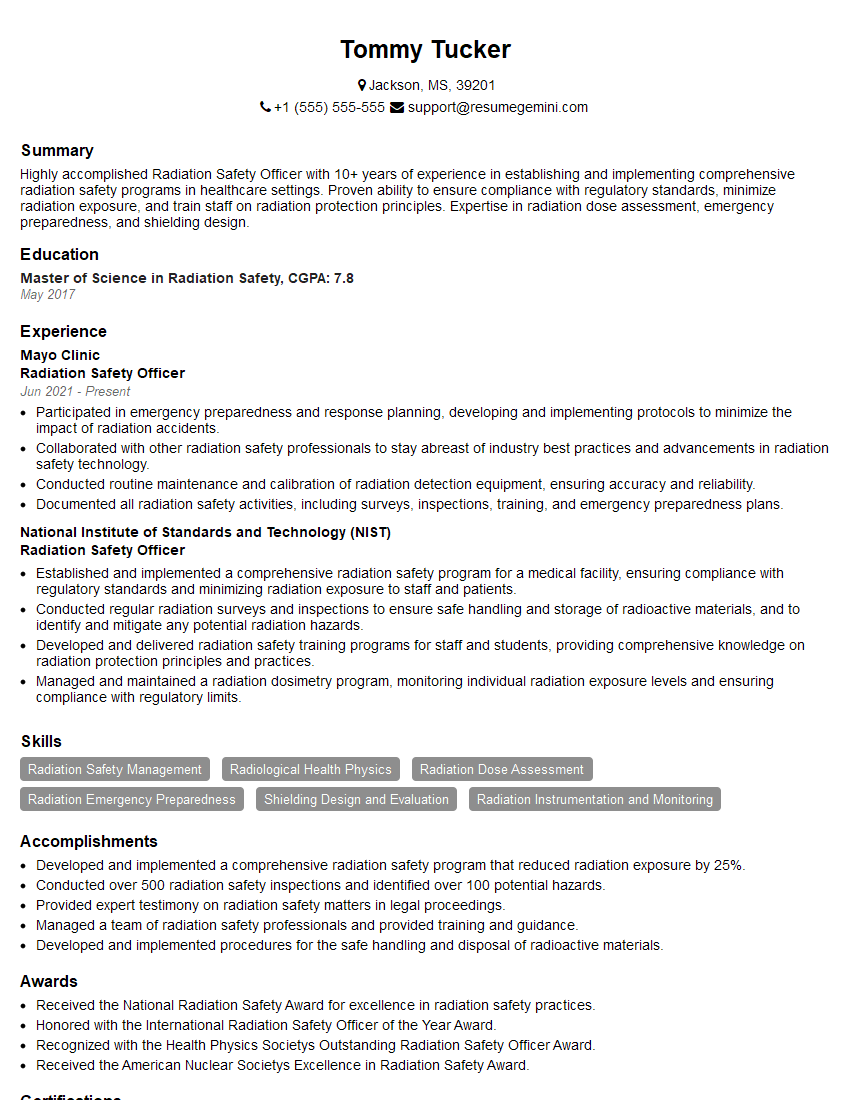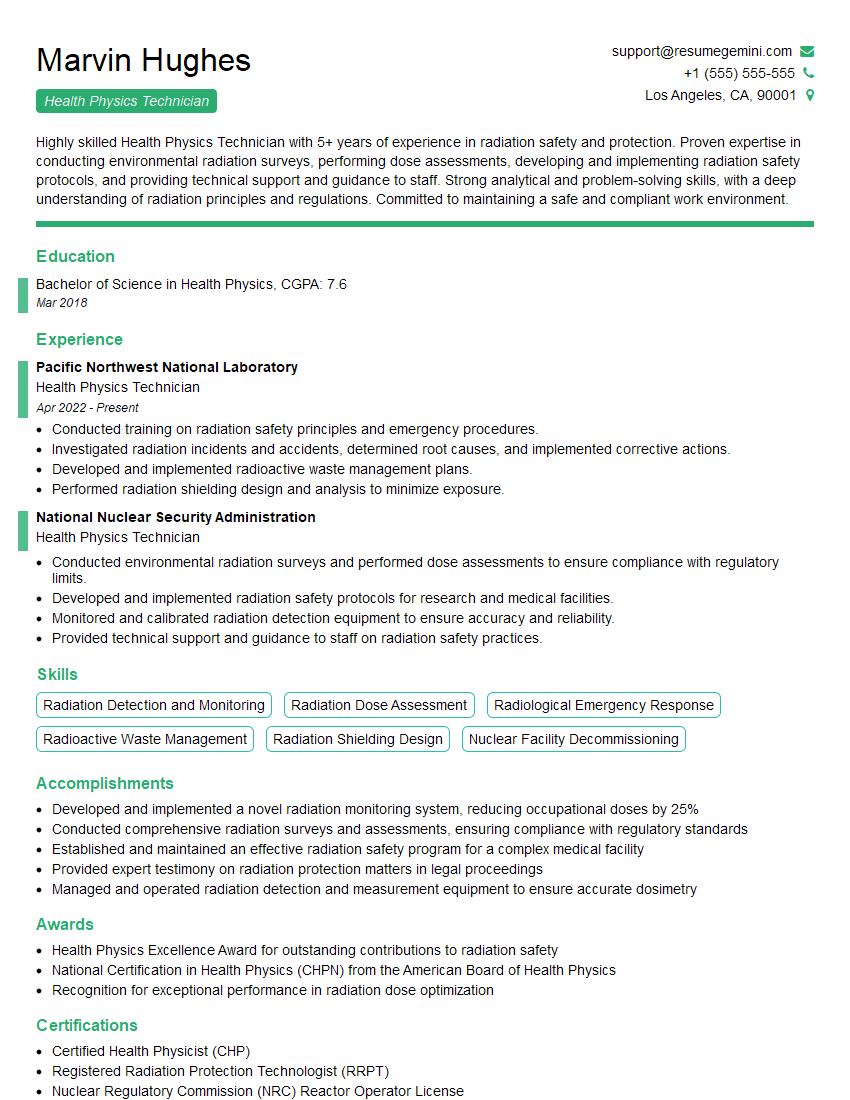Preparation is the key to success in any interview. In this post, we’ll explore crucial Radiation Protection and Shielding interview questions and equip you with strategies to craft impactful answers. Whether you’re a beginner or a pro, these tips will elevate your preparation.
Questions Asked in Radiation Protection and Shielding Interview
Q 1. Explain the ALARA principle and its practical application in radiation protection.
The ALARA principle, which stands for “As Low As Reasonably Achievable,” is a fundamental guideline in radiation protection. It emphasizes that radiation exposure should be kept as low as possible, taking into account social and economic factors. It’s not about eliminating all radiation exposure, which is often impossible, but about minimizing it to levels that are justifiable and practical.
Practical Application: Consider a medical X-ray procedure. ALARA dictates that the radiologist should use the lowest possible radiation dose to obtain a diagnostically useful image. This might involve optimizing the X-ray machine settings, using appropriate shielding, and ensuring the patient is positioned correctly. In nuclear power plants, ALARA is implemented through strict operational procedures, regular monitoring of radiation levels, and the use of protective equipment to minimize worker exposure. It’s a continuous process of optimization, balancing the benefits of a radiation-related activity against the risk. For instance, a slightly higher dose might be acceptable if it leads to a significantly improved diagnostic image in medicine, but only after careful consideration and justification.
Q 2. Describe different types of radiation and their relative biological effectiveness.
Radiation comes in various forms, each with a different ability to damage biological tissue. This ability is quantified by the Relative Biological Effectiveness (RBE). RBE compares the biological effect of a given type of radiation to the effect of a standard radiation, usually X-rays or gamma rays.
- Alpha particles: Heavy, positively charged particles with high RBE. They have a short range in air but cause significant damage if ingested or inhaled.
- Beta particles: Lighter, negatively or positively charged particles with moderate RBE and a longer range than alpha particles.
- Gamma rays and X-rays: Electromagnetic radiation with lower RBE compared to alpha and beta particles, but they have a long range and high penetrating power.
- Neutrons: Uncharged particles with varying RBE depending on their energy. They can cause significant damage through nuclear reactions within the body.
The higher the RBE, the more damaging the radiation is to living tissue at the same dose. For example, alpha particles have a much higher RBE than gamma rays, meaning a smaller dose of alpha radiation can cause the same level of biological damage as a larger dose of gamma radiation. This is why internal contamination with alpha emitters is particularly hazardous.
Q 3. What are the three basic methods of radiation protection?
The three basic methods of radiation protection are based on the principles of time, distance, and shielding. They are always used in combination to achieve optimal protection:
- Time: Reducing the time spent near a radiation source significantly reduces exposure. The longer the exposure, the greater the dose received.
- Distance: Radiation intensity decreases rapidly with increasing distance from the source. This is governed by the inverse square law (explained in the next question).
- Shielding: Using materials that absorb or attenuate radiation. The type and thickness of the shielding depend on the type and energy of the radiation.
Imagine working with a radioactive source: you would minimize your time near the source, work from a safe distance, and use appropriate shielding material (lead, concrete, etc.) to reduce exposure. This combined approach is crucial for effective radiation protection.
Q 4. How do you calculate radiation exposure using the inverse square law?
The inverse square law states that the intensity of radiation is inversely proportional to the square of the distance from the source. The formula is:
I₂ = I₁ * (r₁²/r₂²)
Where:
I₁is the initial intensity of radiation at distancer₁.I₂is the intensity of radiation at distancer₂.r₁is the initial distance from the source.r₂is the new distance from the source.
Example: If the radiation intensity is 100 mSv/h at 1 meter from a source, what is the intensity at 2 meters?
I₂ = 100 mSv/h * (1 m²/2 m²) = 25 mSv/h
Doubling the distance reduces the intensity to one-quarter of its original value. This highlights the importance of distance in radiation protection.
Q 5. Explain the concept of half-life and its relevance in radiation protection.
Half-life is the time it takes for half of the radioactive atoms in a sample to decay. Each radioactive isotope has a characteristic half-life, which can range from fractions of a second to billions of years.
Relevance in Radiation Protection: The half-life dictates how long a radioactive material remains hazardous. A material with a short half-life will decay quickly, reducing its radioactivity and posing less of a long-term threat. Materials with long half-lives, however, remain radioactive for extended periods, requiring careful long-term storage and management. For example, the relatively short half-life of iodine-131 (8 days) means that any contamination will reduce its danger quite quickly, while the extremely long half-life of plutonium-239 (24,000 years) necessitates exceptionally robust containment strategies for spent nuclear fuel.
Q 6. What are the different types of radiation detectors and their applications?
Various radiation detectors are used, each suited to specific applications. They measure different aspects of radiation.
- Geiger-Müller counters: Detect ionizing radiation and are widely used for contamination monitoring and radiation surveys. Simple, robust, and relatively inexpensive.
- Scintillation detectors: Detect radiation by producing light flashes in a scintillating material. Used in various applications, including medical imaging (PET, SPECT), nuclear security, and environmental monitoring. Offer high sensitivity and energy resolution.
- Ionization chambers: Measure radiation by collecting ions produced in a gas. Used for radiation dosimetry and monitoring in high radiation areas. Offer good accuracy over a wide range of radiation intensities.
- Thermoluminescent dosimeters (TLDs): Store radiation energy in a crystalline material and release it as light when heated. Used for personal dosimetry, providing a cumulative measure of radiation exposure over time.
- Solid-state detectors: Utilize semiconductor materials to detect radiation, providing high energy resolution and versatility. Used in applications such as X-ray spectroscopy and nuclear physics research.
The choice of detector depends on the type and energy of radiation, the required sensitivity, and the application context.
Q 7. Describe the process of designing radiation shielding for a specific application.
Designing radiation shielding involves careful consideration of several factors:
- Type and energy of the radiation source: Different materials attenuate different types of radiation more effectively. For example, lead is excellent for shielding gamma rays and X-rays, while concrete is more effective for neutrons.
- Radiation intensity: The higher the intensity, the thicker the shielding required.
- Required dose reduction: The desired level of protection dictates the necessary shielding thickness.
- Space constraints: The available space often limits the thickness and type of shielding that can be used.
- Cost considerations: Different shielding materials have different costs, requiring a balance between effectiveness and expense.
Process: The design process typically involves using radiation transport codes (like MCNP or FLUKA) to simulate radiation transport through different materials. These codes allow for accurate prediction of the shielding effectiveness. The design is iterative, adjusting parameters until the required level of protection is achieved while meeting all the constraints. A detailed analysis of the radiation field, using measurements and calculations, is also critical for validation. Finally, regular inspections and maintenance are vital to ensure the continued effectiveness of the shielding.
Q 8. What are the regulatory requirements for handling radioactive materials in your region?
Regulatory requirements for handling radioactive materials vary significantly by region and are typically governed by national and sometimes international agencies. In many countries, these regulations are based on the principles of ALARA (As Low As Reasonably Achievable) and justification, aiming to minimize radiation exposure to individuals and the environment.
For example, in the United States, the Nuclear Regulatory Commission (NRC) sets stringent standards for licensing, transportation, storage, and use of radioactive materials. These regulations often include detailed procedures for handling specific isotopes, safety protocols for different types of work (e.g., research, medical applications), and requirements for radiation monitoring and personnel training. Similar regulatory bodies exist in other countries, such as the UK’s Office for Nuclear Regulation (ONR) and Canada’s Canadian Nuclear Safety Commission (CNSC). These bodies establish detailed regulations covering aspects from material acquisition and licensing to waste disposal, all with the goal of ensuring public safety.
Specific requirements can include:
- Licensing: Obtaining licenses for possession and use of radioactive materials based on quantity, type and intended use.
- Training: Mandatory training for personnel handling radioactive materials, covering safety procedures and emergency response.
- Monitoring: Regular monitoring of radiation levels in the workplace and personal dosimetry to track individual exposure.
- Waste management: Strict regulations for the safe disposal of radioactive waste, adhering to specific protocols for different waste categories.
- Security: Security measures to prevent theft or unauthorized access to radioactive materials.
Failure to comply with these regulations can lead to significant penalties, including fines and legal actions.
Q 9. Explain the concept of dose rate and its units.
Dose rate refers to the amount of ionizing radiation absorbed per unit of time. It’s a crucial concept in radiation protection, as it directly relates to the potential biological effects of radiation exposure. A higher dose rate means a faster rate of energy deposition in tissue, leading to potentially greater damage.
The standard unit for dose rate is the Sievert per hour (Sv/h) or, more commonly for lower levels, microsieverts per hour (µSv/h). The Sievert (Sv) itself is a unit of equivalent dose, which accounts for the different biological effectiveness of various types of radiation. For example, alpha particles are more biologically damaging than beta particles or gamma rays, so a given amount of alpha radiation will result in a higher equivalent dose in Sieverts than the same amount of energy deposited by beta or gamma radiation. Other units, such as Gray per hour (Gy/h), which measures absorbed dose, are also used but are less common in radiation protection contexts.
Example: A dose rate of 10 µSv/h means that a person exposed to this radiation field for one hour would receive an equivalent dose of 10 µSv. In contrast, a dose rate of 1 mSv/h (1000 µSv/h) represents a significantly higher risk.
Q 10. How do you assess the risk associated with a radiation source?
Risk assessment for radiation sources is a systematic process that involves evaluating the potential hazards associated with the source and the likelihood of exposure. It’s a crucial step in implementing appropriate safety measures. A thorough risk assessment considers several key factors:
- Source characteristics: Type and activity (strength) of the radioactive material, the type of radiation emitted (alpha, beta, gamma, neutron), and its physical and chemical form.
- Exposure pathways: How might individuals be exposed? This includes inhalation, ingestion, or external exposure via direct radiation or contamination.
- Exposure scenarios: Considering potential scenarios, such as routine operation, accidents, or emergencies, and the likelihood of each.
- Individual susceptibility: Age, health condition, and pregnancy status can affect an individual’s sensitivity to radiation.
- Duration and frequency of exposure: The length and frequency of exposure significantly impact the overall dose received.
This information is then used to estimate the potential dose to individuals and the associated health risks. This might involve calculations based on distance, shielding, and the time spent near the source. Quantitative risk assessment may involve using models and software to simulate different exposure scenarios and predict potential doses. Qualitative risk assessments focus on identifying potential hazards and using ranking systems to categorize the level of risk. Regulatory limits and safety standards are then used to determine if the risks are acceptable or if additional safety measures are required. The process is iterative, with regular reviews and updates to reflect any changes in the source, operations, or understanding of radiation risks.
Q 11. Describe different types of personnel monitoring devices and their limitations.
Personnel monitoring devices are used to track individual radiation exposure. Different types exist, each with its own advantages and limitations:
- Film badges: These use photographic film that darkens proportionally to the radiation dose received. They are relatively inexpensive but provide a limited dose range and require processing before results are available. They offer limited energy discrimination.
- Thermoluminescent dosimeters (TLDs): These crystals store energy when exposed to radiation, which is released as light when heated. TLDs offer better sensitivity and energy discrimination than film badges. However, they are more expensive and also require processing.
- Optically stimulated luminescence dosimeters (OSLDs): Similar to TLDs, but stimulate the emission of light using a laser. They provide high sensitivity, a wide dynamic range, and are reusable. However, OSLDs require specialized readers.
- Electronic personal dosimeters (EPDs): These devices directly measure radiation levels and provide real-time readings. EPDs are convenient and offer immediate feedback. However, they are typically more expensive and have a limited battery life, and require regular calibration.
Limitations: All these devices have limitations. They may not accurately measure all types of radiation (e.g., neutron radiation). They are sensitive to environmental factors like temperature and humidity, and their accuracy can be affected by improper handling or storage. Furthermore, they only measure external radiation exposure, and may not detect internal contamination.
Q 12. Explain the difference between internal and external radiation exposure.
The difference between internal and external radiation exposure lies in how the radiation interacts with the body:
- External radiation exposure: Occurs when a person is exposed to radiation from a source outside their body. The radiation may penetrate the body and deposit energy in the tissues, potentially causing damage. Shielding and distance are effective methods of reducing external radiation exposure. Examples include exposure to gamma rays from a radioactive source or X-rays during medical imaging.
- Internal radiation exposure: Occurs when radioactive material is ingested, inhaled, or absorbed into the body. The radioactive material then emits radiation internally, irradiating the tissues from within. This type of exposure is more hazardous as the radiation is in direct contact with the body’s cells. Internal contamination requires different mitigation strategies, often involving medical interventions to remove the radioactive material from the body. Examples include ingestion of contaminated food or inhalation of radioactive dust or gases.
Both types of exposure pose health risks, but internal exposure typically carries a higher risk due to the proximity of the radiation source to sensitive tissues.
Q 13. What are the common methods used for decontamination of radioactive materials?
Decontamination of radioactive materials involves removing or reducing radioactive contamination from surfaces, equipment, or personnel. Methods used depend on the type and level of contamination, the material involved, and the surrounding environment. Some common methods include:
- Washing and scrubbing: Simple washing with soap and water can remove loosely bound contamination. More thorough scrubbing may be needed for persistent contamination.
- Chemical decontamination: Using chemical agents to dissolve or remove radioactive materials. The choice of chemical depends on the radioactive material and the surface involved. Acidic or alkaline solutions, chelating agents, or oxidizing agents may be used.
- Mechanical removal: Removing contaminated surfaces or layers, such as peeling paint or sanding down surfaces. Vacuum cleaning or high-pressure water jets may also be used.
- Specialized techniques: For complex decontamination, specialized techniques may be required such as ultra-sonic cleaning or electropolishing.
Decontamination always follows established safety procedures, often requiring the use of personal protective equipment (PPE), such as respirators, gloves, and protective clothing. Monitoring equipment is used to assess the effectiveness of decontamination. Proper disposal of contaminated materials is crucial, following established regulatory guidelines.
Q 14. Describe the process of radiation emergency response planning.
Radiation emergency response planning involves developing and implementing procedures to mitigate the consequences of a radiation accident or incident. This process is crucial to minimizing exposure and protecting public health. A comprehensive plan typically includes the following steps:
- Hazard identification and risk assessment: Identifying potential radiation sources, assessing their risks, and defining potential emergency scenarios.
- Emergency response procedures: Developing detailed procedures for different scenarios, including incident detection, notification, evacuation, and medical treatment.
- Communication plan: Establishing procedures for communicating information to the public, emergency responders, and other relevant authorities.
- Personnel training and exercises: Regular training and drills for personnel involved in emergency response.
- Resource allocation: Identifying and securing resources necessary for emergency response, such as equipment, personnel, and facilities.
- Post-accident assessment: Procedures for evaluating the impact of the accident, assessing levels of contamination, and planning remediation efforts.
Effective radiation emergency response planning requires close collaboration between various agencies, including regulatory bodies, emergency services, medical personnel, and other stakeholders. Regular reviews and updates to the plan are essential to ensure its continued effectiveness.
Q 15. Explain the role of a radiation protection officer in a nuclear power plant.
The Radiation Protection Officer (RPO) in a nuclear power plant is the cornerstone of radiation safety. They are responsible for ensuring that all radiation-related activities are conducted safely and within regulatory limits, protecting both workers and the public. This involves a multifaceted role encompassing:
- Developing and implementing radiation protection programs: This includes creating and updating safety procedures, conducting risk assessments, and ensuring compliance with national and international regulations.
- Monitoring radiation levels: The RPO utilizes various instruments to regularly monitor radiation levels throughout the plant, identifying and mitigating potential hazards.
- Training and education: They are responsible for providing comprehensive training to all personnel on radiation safety procedures, emphasizing safe work practices and emergency response protocols.
- Investigating incidents and accidents: In case of radiation-related incidents or accidents, the RPO leads the investigation, identifies the root cause, and recommends corrective actions to prevent future occurrences.
- Maintaining accurate records: Meticulous record-keeping of radiation doses, monitoring results, and safety procedures is crucial for demonstrating compliance and identifying trends.
- Interfacing with regulatory bodies: The RPO acts as the primary liaison between the plant and regulatory agencies, ensuring transparent communication and compliance with all requirements.
Imagine the RPO as the plant’s ‘radiation safety guardian,’ ensuring a safe working environment for everyone while upholding the highest standards of regulatory compliance.
Career Expert Tips:
- Ace those interviews! Prepare effectively by reviewing the Top 50 Most Common Interview Questions on ResumeGemini.
- Navigate your job search with confidence! Explore a wide range of Career Tips on ResumeGemini. Learn about common challenges and recommendations to overcome them.
- Craft the perfect resume! Master the Art of Resume Writing with ResumeGemini’s guide. Showcase your unique qualifications and achievements effectively.
- Don’t miss out on holiday savings! Build your dream resume with ResumeGemini’s ATS optimized templates.
Q 16. How do you manage and dispose of radioactive waste?
Managing and disposing of radioactive waste is a critical aspect of nuclear power plant operation, requiring a multi-step process focused on safety and environmental protection. The process typically involves:
- Classification: Radioactive waste is categorized based on its level of radioactivity and physical form (e.g., liquid, solid, gaseous). This classification determines the appropriate handling and disposal methods.
- Treatment and Conditioning: Depending on the waste type, various treatment methods are used to reduce volume, immobilize radioactivity, and enhance stability for long-term storage or disposal. This may involve processes like evaporation, solidification, and incineration.
- Storage: Short-lived waste is often stored temporarily on-site in appropriately shielded containers, while long-lived high-level waste requires specialized long-term storage facilities, often in deep geological repositories. These facilities are rigorously designed to prevent leakage and environmental contamination.
- Disposal: Ultimately, the goal is safe and permanent disposal. Low-level waste might be disposed of in near-surface repositories, while high-level waste requires deep geological disposal in stable geological formations that minimize the risk of future release.
For example, spent nuclear fuel, a high-level waste, is typically stored in water-filled pools or dry storage casks on-site before being transferred to a permanent disposal facility. The entire process is governed by strict regulations to ensure public and environmental safety. Each step is thoroughly documented and monitored.
Q 17. What are the biological effects of ionizing radiation on human cells?
Ionizing radiation, due to its high energy, can interact with atoms in human cells, causing ionization and excitation. This can lead to a range of biological effects, depending on the dose and type of radiation. These effects can be broadly classified into:
- Deterministic effects: These effects have a threshold dose; below this threshold, no effect is observed. The severity of the effect increases with dose. Examples include skin burns, cataracts, and radiation sickness (acute radiation syndrome).
- Stochastic effects: These effects have no threshold; the probability of occurrence increases with dose, but the severity is independent of the dose. The primary stochastic effect is cancer. Genetic effects (mutations) are also stochastic.
At the cellular level, radiation damage can cause DNA strand breaks, chromosomal aberrations, and cell death. The body has repair mechanisms, but if the damage is extensive, it can lead to mutations that could eventually result in cancer or other health problems. The specific effects depend on several factors including the type of radiation, dose rate, and the individual’s susceptibility. For instance, high-energy alpha particles are more damaging than low-energy beta particles due to their high linear energy transfer (LET).
Q 18. Explain the concept of effective dose and equivalent dose.
Both effective dose and equivalent dose are used to quantify the biological impact of radiation exposure, but they account for different aspects:
- Equivalent Dose (HT): This quantifies the biological damage to a specific organ or tissue (T) by weighting the absorbed dose (DT) by a radiation weighting factor (wR). This factor accounts for the different biological effectiveness of various types of radiation. The unit is Sievert (Sv).
- Effective Dose (E): This considers the overall biological risk from radiation exposure by weighting the equivalent dose to each organ or tissue by a tissue weighting factor (wT). These factors reflect the varying radiosensitivity of different organs. The unit is also Sievert (Sv).
In simpler terms, equivalent dose tells us how much damage a specific type of radiation does to a specific organ, while effective dose considers the overall risk of radiation-induced harm to the whole body. For example, a 1 mSv equivalent dose to the thyroid gland will contribute to a smaller effective dose compared to a 1 mSv equivalent dose to the bone marrow, because of the different tissue weighting factors.
E = Σ wT HT
Q 19. What are the different types of radiation shielding materials and their properties?
Radiation shielding materials are chosen based on their ability to absorb or attenuate radiation. Different materials are effective against different types of radiation:
- Lead (Pb): Excellent for shielding against gamma rays and X-rays due to its high atomic number. It’s commonly used in radiation protection equipment and shielding structures.
- Concrete: Widely used due to its cost-effectiveness and availability. Ordinary concrete is effective for gamma and X-ray shielding, especially with high density varieties.
- Steel: Offers good shielding for beta particles and lower-energy gamma rays. Often used in combination with other materials.
- Water: Effective for shielding against neutrons due to its hydrogen content. Water is used in nuclear reactors and in shielding around neutron sources.
- Boron: Excellent neutron absorber, often incorporated into shielding materials. Boron-containing compounds are used in neutron shielding applications.
The effectiveness of a shielding material is determined by its thickness, density, and atomic number. Thicker materials generally provide better shielding, but practical considerations like cost and weight often necessitate finding the optimal balance.
Q 20. Describe the process of conducting a radiation survey.
A radiation survey is a systematic measurement of radiation levels in a specific area. This is crucial for ensuring worker safety and environmental protection. The process involves:
- Planning: Defining the scope of the survey, including the areas to be surveyed, the types of radiation to be measured, and the required accuracy.
- Instrument selection: Choosing appropriate radiation detection instruments, such as Geiger-Müller counters, scintillation detectors, or survey meters, based on the type and energy of radiation expected.
- Calibration: Ensuring that all instruments are properly calibrated to provide accurate readings. Regular calibration is essential for maintaining accuracy.
- Measurement: Systematically measuring radiation levels in the designated areas, following established procedures and recording the readings with associated metadata such as date, time, and location.
- Data analysis: Analyzing the collected data to identify areas of high radiation levels, potential sources of radiation, and compliance with regulatory limits.
- Reporting: Preparing a comprehensive report summarizing the survey results, including any findings, conclusions, and recommendations for corrective actions if needed.
For example, a survey might be conducted after a spill of radioactive material to assess contamination levels and guide cleanup efforts. Regular surveys are also performed in nuclear facilities to monitor radiation levels and ensure worker safety.
Q 21. Explain the use of Monte Carlo simulations in radiation transport calculations.
Monte Carlo simulations are powerful computational tools used to model and predict the transport of radiation through matter. They work by simulating the individual interactions of radiation particles (photons, neutrons, etc.) with the material using probabilistic methods.
Instead of solving complex deterministic equations, the Monte Carlo method uses random numbers to simulate the individual particle trajectories and interactions. By simulating a large number of particle histories, statistically accurate estimates of radiation transport parameters such as fluence, dose, and current can be obtained.
How it Works:
- Particle generation: The simulation starts by generating radiation particles with specific energies and directions.
- Interaction simulation: The program simulates the interaction of each particle with the material, based on known physical cross-sections and interaction probabilities.
- Tracking and scoring: The program tracks the particle’s trajectory and scores relevant parameters such as energy deposition, particle fluence, etc.
- Statistical analysis: After simulating a large number of particle histories, the results are statistically analyzed to obtain the final quantities of interest.
Monte Carlo simulations are widely used in radiation protection for designing shielding, calculating radiation doses in medical treatments, and analyzing radiation transport in nuclear reactors. These simulations provide valuable insights that are difficult or impossible to obtain through experimental methods alone. The accuracy of the simulations relies heavily on the accuracy of the underlying physical models and cross-section data.
Q 22. How do you calculate the shielding required for a specific gamma source?
Calculating the shielding required for a gamma source involves understanding the source’s activity, the energy of the emitted gamma rays, the desired dose rate at a specific distance, and the shielding material’s properties. The basic principle relies on the exponential attenuation of gamma rays as they pass through matter.
We use the following formula:
I = I₀ * e^(-μx)Where:
Iis the intensity of radiation after passing through the shield.I₀is the initial intensity of radiation.μis the linear attenuation coefficient of the shielding material (dependent on the gamma ray energy and material). This value is usually obtained from tables or databases.xis the thickness of the shielding material.
To determine the required shielding thickness (x), we rearrange the formula and take the natural logarithm:
x = -ln(I/I₀) / μFor example, let’s say we have a 60Co source emitting 1.17 MeV and 1.33 MeV gamma rays. We want to reduce the intensity at 1 meter from 100 mSv/h to 1 mSv/h. Using the linear attenuation coefficient for lead at these energies (obtained from a reference table), we can calculate the required lead thickness. It’s crucial to consider multiple energy emissions if the source produces gamma rays at various energies and to calculate the shielding for each energy separately. Then a conservative thickness which reduces the dose below the required level is selected.
This is a simplified model. In practice, we also need to consider:
- Scattering: Gamma rays can scatter off the shielding material, increasing the dose. This necessitates incorporating buildup factors in our calculation to account for this effect.
- Geometry: The geometry of the source and shield significantly influences the dose rate. Simple point source calculations often underestimate shielding requirements in real-world applications.
- Material Selection: Different materials offer different attenuation properties. Lead is commonly used for its high density, but other materials like concrete or steel may be more cost-effective or practical depending on the situation.
Professional shielding design software and Monte Carlo simulations are often used for complex scenarios to account for these factors accurately.
Q 23. What are the challenges associated with radiation protection in medical applications?
Radiation protection in medical applications presents unique challenges due to the inherent need to expose patients to ionizing radiation for diagnostic and therapeutic purposes. The primary challenge is balancing the benefits of radiation-based procedures (improved diagnosis, effective treatment) with the risks of radiation-induced harm.
Here are some key challenges:
- Optimizing radiation dose: Minimizing patient dose while maintaining diagnostic image quality or therapeutic efficacy is a constant balancing act. This involves sophisticated techniques like image optimization, radiation beam collimation, and the use of lower radiation doses wherever possible.
- Patient safety: Ensuring patient safety requires rigorous quality control procedures, accurate dosimetry, and careful radiation safety protocols. This includes shielding of vulnerable organs and tissues from unnecessary irradiation.
- Staff protection: Medical personnel who work with radiation sources are at risk of long-term health effects. Effective shielding, proper work practices, and regular radiation monitoring are essential to limit their exposure.
- Regulatory compliance: Medical facilities must adhere to strict regulations governing the use and safety of radiation sources, including licensing, equipment maintenance, and staff training. These regulations vary across countries and jurisdictions, adding complexity to the task of compliance.
- Technological advancements: The rapid advancement of medical imaging and radiation therapy techniques presents ongoing challenges in ensuring the safety of both patients and staff. New technologies often require new safety protocols and ongoing professional development for staff.
For example, a common challenge is the scattered radiation from a patient during a CT scan which exposes healthcare workers. This requires careful shielding design of the CT room and adherence to ALARA principles (As Low As Reasonably Achievable).
Q 24. Explain the concept of criticality safety.
Criticality safety is the prevention of accidental nuclear chain reactions, specifically in situations involving fissile materials like uranium-235 or plutonium-239. These materials can sustain a chain reaction under specific conditions of mass and geometry, leading to a criticality excursion—a sudden release of a large amount of energy in the form of neutrons, gamma radiation, and heat. This can have devastating consequences including severe radiation exposure and potential facility damage.
The core principles of criticality safety revolve around preventing the accumulation of fissile material beyond a critical mass and optimizing the geometry to avoid chain reactions. Key strategies include:
- Subcriticality: Keeping the amount of fissile material well below the critical mass to prevent a chain reaction.
- Geometry control: Careful design of storage containers and process equipment to prevent the formation of a critical geometry (critical configurations can often be accidental, for example when materials are dropped together or accidentally stored together).
- Neutron poisons: Incorporating materials that absorb neutrons (such as boron or cadmium) into fissile material systems to reduce the probability of a chain reaction.
- Administrative controls: Implementing strict procedures and controls to manage fissile materials, such as limiting access, using strict inventory control and employing strict process procedures.
- Criticality alarms and monitoring systems: Deploying monitoring systems to detect and warn of an impending criticality excursion or to verify that no criticality event has occurred.
A classic example of a criticality accident involved a poorly designed storage container for fissile solutions, where a shift of materials within a large batch resulted in accidental criticality.
Q 25. Describe the different types of radiation accidents and their consequences.
Radiation accidents encompass a wide range of incidents involving unintended exposure to ionizing radiation. The consequences vary greatly depending on the type and magnitude of the event, the type and amount of radiation involved and the duration of exposure.
Types of radiation accidents and their consequences:
- Criticality accidents: As explained previously, these involve uncontrolled nuclear chain reactions, leading to intense radiation exposure, potentially resulting in severe radiation sickness, acute radiation syndrome, and long-term health problems including cancer and other effects. These are extremely dangerous accidents and pose significant health risks for anyone exposed.
- Sealed source accidents: These occur when a sealed radioactive source is damaged or lost, releasing radioactive material into the environment. Consequences depend on the type and amount of radioactive material released. They can range from localized contamination requiring decontamination efforts to more widespread environmental contamination demanding extensive remediation measures.
- Medical radiation accidents: These can involve misadministration of radiation therapy (e.g., incorrect dosage), malfunction of medical imaging equipment, or accidents involving radioactive materials used in medical procedures. Consequences can include patient injury or death, and radiation exposure for medical staff.
- Transportation accidents: Accidents involving the transportation of radioactive materials can lead to the release of radioactive material into the environment, and can present a risk to emergency responders and the public, and potentially extensive environmental contamination.
- Industrial accidents: Accidents involving radioactive materials in industrial settings (e.g., nuclear power plants, research facilities) can have serious consequences, depending on the nature and magnitude of the event. These can result in significant environmental and health risks for workers and the public.
In any radiation accident, prompt response and mitigation are crucial to minimize the consequences. This includes evacuation, decontamination, medical treatment, and environmental remediation as needed.
Q 26. What are the ethical considerations in radiation protection?
Ethical considerations in radiation protection are paramount. The core ethical principle is to protect individuals from unnecessary radiation exposure, balancing the risks and benefits of any radiation-related activity.
Key ethical considerations include:
- ALARA principle: The fundamental principle of keeping radiation exposure As Low As Reasonably Achievable, even if the exposure is below regulatory limits.
- Informed consent: Individuals have the right to be fully informed about the risks and benefits of any radiation exposure before they consent to a procedure (particularly in medical applications).
- Justice and equity: Ensuring equitable distribution of risks and benefits from radiation-related activities, especially considering vulnerable populations.
- Transparency and accountability: Open communication about radiation risks and safety measures; accountability for radiation safety practices. This involves transparent reporting of incidents and lessons learned.
- Protecting future generations: Radiation protection should consider the long-term consequences, including the impact on future generations.
For instance, a radiologist must ethically consider the benefits of a particular diagnostic imaging procedure against the potential radiation risks for the patient. Detailed patient information and the discussion of alternative approaches should be part of the ethical consideration to minimize patient exposure while delivering the needed diagnostic information.
Q 27. Explain the importance of radiation protection training and education.
Radiation protection training and education are crucial for ensuring the safety of individuals and the environment. Effective training programs are designed to equip individuals with the knowledge and skills necessary to work safely with ionizing radiation, prevent accidents, and respond appropriately to radiation emergencies.
The importance of training and education:
- Preventing accidents: Training instills safe work practices, providing staff with the necessary knowledge and skills to avoid accidents and reduce radiation exposure.
- Responding to accidents: Education helps individuals understand the risks associated with radiation exposure and how to respond appropriately in the event of an emergency.
- Ensuring compliance: Training enables compliance with radiation safety regulations, licensing requirements, and industry standards.
- Maintaining a safe work environment: Regular training and education helps to maintain a culture of safety within organizations that work with radiation sources, minimizing risk exposure.
- Improving professional competency: Ongoing training enhances professional knowledge and competency, improving effectiveness of radiation safety programs.
Different levels of training exist depending on the occupation and the extent of radiation exposure. For example, a medical physicist involved in radiation therapy requires a very different level of training and qualification than a radiation worker handling radioactive materials in an industrial setting. Effective training programs must be tailored to the specific needs of the individual and the context in which they work.
Key Topics to Learn for Radiation Protection and Shielding Interview
- Radiation Sources and Types: Understand the different types of ionizing radiation (alpha, beta, gamma, neutron, X-rays), their properties, and common sources in various applications (medical, industrial, research).
- Interaction of Radiation with Matter: Master the fundamental principles of how radiation interacts with different materials. This includes concepts like absorption, scattering, and attenuation.
- Shielding Design Principles: Learn the practical applications of shielding calculations and design. This includes selecting appropriate shielding materials based on radiation type and energy, optimizing shield thickness, and understanding geometrical considerations.
- Radiation Dosimetry and Measurement: Familiarize yourself with radiation detection techniques, units of measurement (Sieverts, Gray, Becquerel), and the principles behind different types of radiation detectors (Geiger counters, scintillation detectors).
- Radiation Protection Regulations and Standards: Understand relevant safety regulations and standards (e.g., ALARA principle, ICRP recommendations) and their practical implications in various work environments.
- Risk Assessment and Management: Develop your ability to assess radiation risks, implement control measures, and manage potential hazards effectively. This includes understanding dose limits and emergency response procedures.
- Practical Applications in Different Industries: Explore the diverse applications of radiation protection and shielding in various sectors like nuclear power, medical imaging, industrial radiography, and research facilities. Be prepared to discuss your experience (or theoretical understanding) of these applications.
- Problem-Solving and Critical Thinking: Practice applying your theoretical knowledge to real-world scenarios. Be ready to discuss how you would approach a given radiation protection challenge, demonstrating your problem-solving skills.
Next Steps
Mastering Radiation Protection and Shielding is crucial for a successful and rewarding career in a high-demand field. Strong knowledge in this area opens doors to exciting opportunities and positions you for leadership roles within various industries. To significantly increase your chances of landing your dream job, it’s essential to create a compelling and ATS-friendly resume that highlights your skills and experience effectively. ResumeGemini is a trusted resource to help you build a professional and impactful resume. We provide examples of resumes tailored specifically to Radiation Protection and Shielding professionals to help you craft a document that stands out from the competition. Take the next step in your career journey and build a resume that showcases your expertise.
Explore more articles
Users Rating of Our Blogs
Share Your Experience
We value your feedback! Please rate our content and share your thoughts (optional).
What Readers Say About Our Blog
Hello,
We found issues with your domain’s email setup that may be sending your messages to spam or blocking them completely. InboxShield Mini shows you how to fix it in minutes — no tech skills required.
Scan your domain now for details: https://inboxshield-mini.com/
— Adam @ InboxShield Mini
Reply STOP to unsubscribe
Hi, are you owner of interviewgemini.com? What if I told you I could help you find extra time in your schedule, reconnect with leads you didn’t even realize you missed, and bring in more “I want to work with you” conversations, without increasing your ad spend or hiring a full-time employee?
All with a flexible, budget-friendly service that could easily pay for itself. Sounds good?
Would it be nice to jump on a quick 10-minute call so I can show you exactly how we make this work?
Best,
Hapei
Marketing Director
Hey, I know you’re the owner of interviewgemini.com. I’ll be quick.
Fundraising for your business is tough and time-consuming. We make it easier by guaranteeing two private investor meetings each month, for six months. No demos, no pitch events – just direct introductions to active investors matched to your startup.
If youR17;re raising, this could help you build real momentum. Want me to send more info?
Hi, I represent an SEO company that specialises in getting you AI citations and higher rankings on Google. I’d like to offer you a 100% free SEO audit for your website. Would you be interested?
Hi, I represent an SEO company that specialises in getting you AI citations and higher rankings on Google. I’d like to offer you a 100% free SEO audit for your website. Would you be interested?
good
